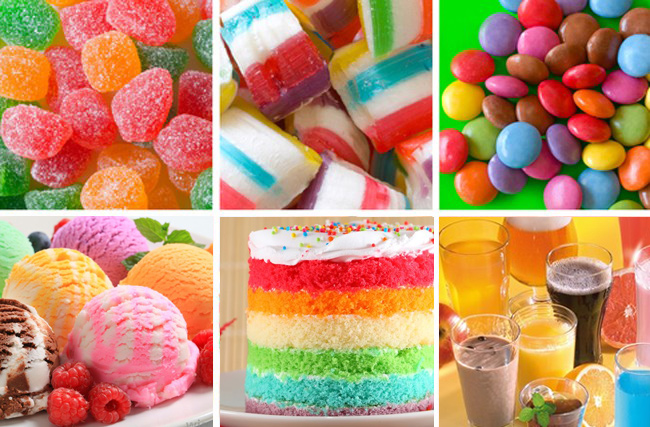know about the colour additives types and regulations and diseases caused by the usage of colour additives
Colour Additives-What is it?
Colour additives are dyes, pigments, or substances that bestow colour to food, drug, or the human body in order to make them attractive.
Types of Colour Additives
Natural Additives
Natural food colour additives are extracted from vegetables or minerals that help in colouring food substances. Seeds, fruits, vegetables and algae are used for the extraction of dyes. These additives maintain the standards of colour additives types and regulations.
Different Natural Colours
- Red, Blue and Violet: Anthocyanins found in beetroots, raspberries and red cabbages.
- Green: Chlorophylls found in all leaves and stems.
- Yellow, Orange, Red: Carotenoids found in Tomatoes Apricots and Carrots.
Synthetic Colour Additives Types and Regulations
These are artificial colouring agents that are manufactured by chemical reactions and are commonly used in the food and pharmaceutical industries.
Some of the standard food colours are Tartrazine, Sunset Yellow, Amaranth, Allura Red, Quinoline Yellow, Brilliant Blue and Indigo Carmine.
Some of the primary colour additives types and regulations leveraged in the industries are
Brilliant Blue, E133 (Blue shade)
Indigotine, E132 (Dark Blue shade)
Fast Green, E143 (Bluish-green shade)
Allura Red AC, E129 (Red shade)
Erythrosine, E127 (Pink shade)
Tartrazine, E102 (Yellow shade)
Sunset Yellow, E110 (Orange shade)


Psychological Properties of Food Color Additives Types and Regulations
Red
Psychological Association: Physical
Positive: Physical courage, strength, warmth, energy, basic survival, ‘fight or flight’, stimulation, masculinity, excitement.
Negative: Defiance, aggression, visual impact, strain.
Blue
Psychological Association: Intellectual
Positive: Intelligence, communication, trust, efficiency, serenity, duty, logic, coolness, reflection, calm
Negative: Coldness, aloofness, lack of emotion, unfriendliness
Yellow
Psychological Association: Emotional
Positive: Optimism, confidence, self-esteem, extraversion, emotional strength, friendliness, creativity
Negative: Irrationality, fear, emotional fragility, depression, anxiety, suicide
Green
Psychological Association: Balance
Positive: Harmony, balance, refreshment, universal love, rest, restoration, reassurance, environmental awareness, equilibrium, peace
Negative: Boredom, stagnation, blandness, enervation
Violet (Purple)
Psychological Association: Spiritual
Positive: Spiritual awareness, containment, vision, luxury, authenticity, truth, quality.
Negative: Introversion, decadence, suppression, inferiority
Orange
Positive: Physical comfort, food, warmth, security, sensuality, passion, abundance, fun
Negative: Deprivation, frustration, frivolity, immaturity
Pink
Positive: Physical tranquility, nurture, warmth, femininity, love, sexuality, survival of the species
Negative: Inhibition, emotional claustrophobia, emasculation, physical weakness
Grey
Positive: Psychological neutrality
Negative: Lack of confidence, dampness, depression, hibernation, lack of energy
Black
Positive: Sophistication, glamour, security, emotional safety, efficiency, substance
Negative: Oppression, coldness, menace, heaviness
White
Positive: Hygiene, sterility, clarity, purity, cleanness, simplicity, sophistication, efficiency
Negative: Sterility, coldness, barriers, unfriendliness, elitism
Brown
Positive: Seriousness, warmth, Nature, earthiness, reliability, support
Negative: Lack of humour, heaviness, lack of sophistication
Color Order Chart
Used in
- Bakery
- Beverage
- Confectionery
- Pharmaceutical Products
- Blended food colours
- Dairy & Icecream
- Cosmetics & Toiletries
- Soft Drink Concentrates
- Squashes
- Medicines
- Seafood
- All Edible preparations

Regulations for food colour additives
The Food Safety and Standards Authority of India (FSSAI), which is a statutory body under the Food Safety and Standards Act, 2006, controls and ensures food safety standards in food colour additives types and regulations. FSSAI has set forth safety regulations for the usage of food colours.
FDA is accountable for regulating all colour additives types and regulations to ensure that foods containing colour additives are safe to eat, contain only approved ingredients and are accurately labelled.
Food additives represented by the manufacturers are put on the labels in the form of codes called E- numbers. The E number range for colours is from E100- E199.
Colour additives functions and benefits
Colour additives can ensure flavour in all the food items from candy to wine, enhance colour, correct natural variations in colour, make food more appetising and informative, and ensure the consistency and visual decoration of the product.
Harmfulness of colour additives
While there are several benefits of colour additives types and regulations agencies have predicted that these colour additives can cause highly dangerous diseases such as ADHD, Cancer, Hypersensitivity.
- ADHD: Attention Deficit Hyperactivity Disorder is solitary of the highly common mental disorders, noticed in children who can continue to their adolescence and adulthood. ADHD characterised by hyperactivity, unable to focus on things or to pay attention. Many sources predict that ADHD caused due to increased intake of foods that contain colour additives. Therefore, it is advisable to reduce the consumption of foods that contain harmful and excessive colour additives. All the parents should be aware of what their children are having and see to that they do not consume colour additive added foods.
- Cancer: Cancer has become the buzz word these days, owing to several cancer cases. Though there is no evidence that these additives result in cancer, many closed survey and research proved excessive intake of additives add might result in tumour and cancer
Following is the detailed list of colour additives and their harmful effects
| Additives | Harmful Effects |
| FD & C BLUE 1 | Genotoxicity, Carcinogenicity, Neurotoxicity |
| FD & C BLUE 2 | Genotoxicity, Carcinogenicity |
| CITRUS RED 2 | Bladder Carcinogen |
| ORANGE- B | Chronic Toxicity |
| FD & C RED 40 | Hypersensitivity, Carcinogen |
| FD & C YELLOW 5 | Asthma, Urticarial, Hypersensitivity effects |
| FD& C YELLOW 6 | Hypersensitivity, Carcinogenicity, Behavioural effects |
For more details about various courses, check out Ampersand Academy.
